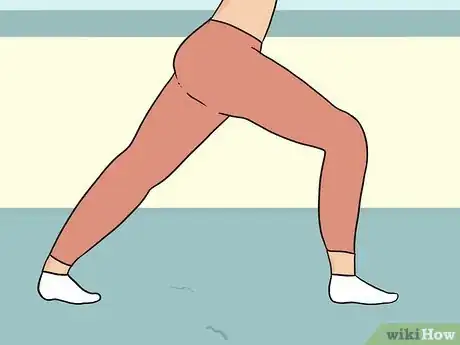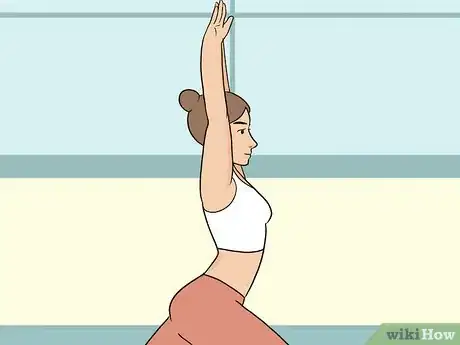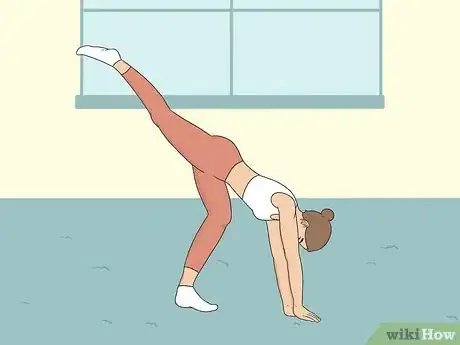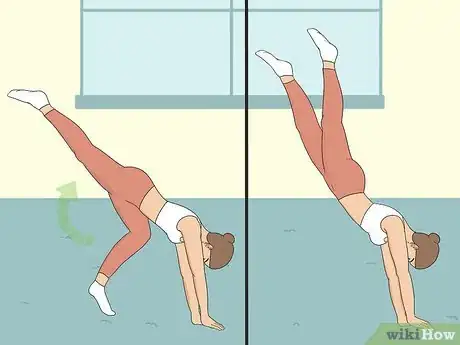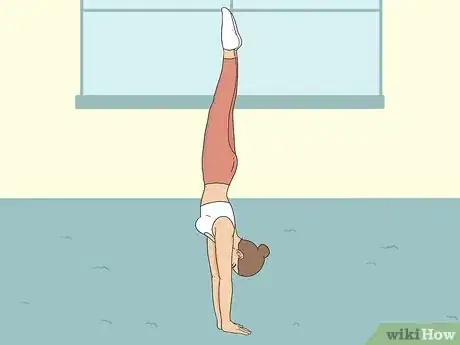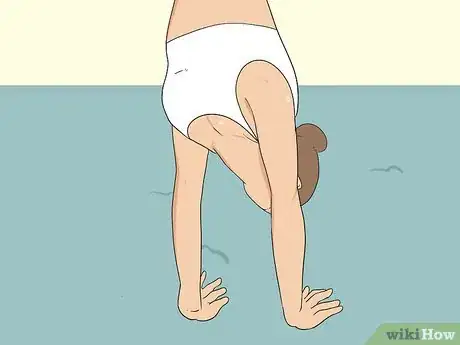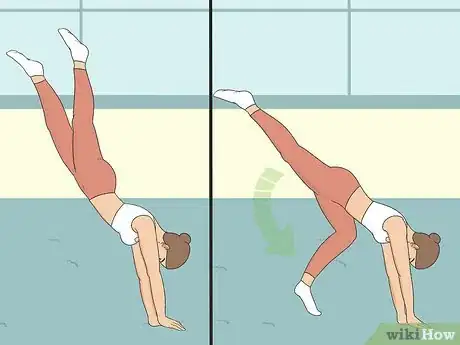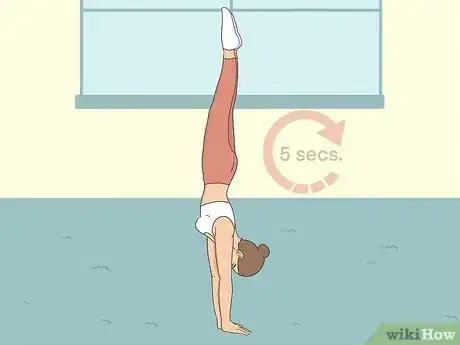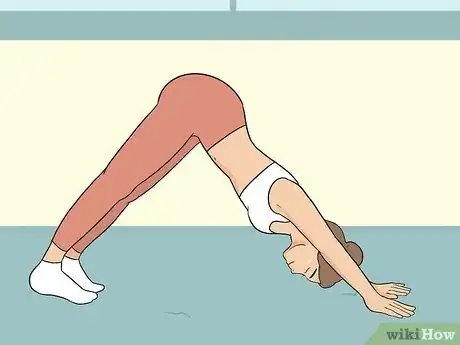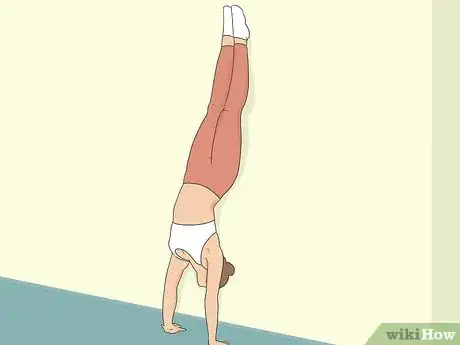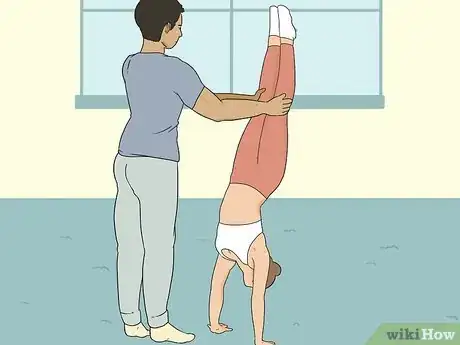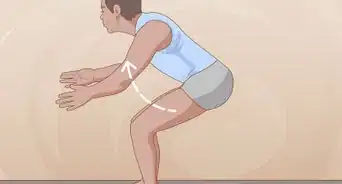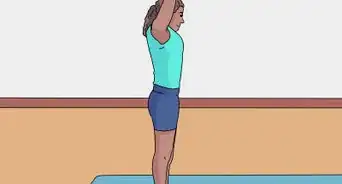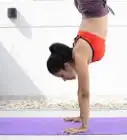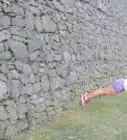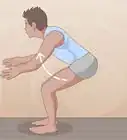This article was co-authored by wikiHow Staff. Our trained team of editors and researchers validate articles for accuracy and comprehensiveness. wikiHow's Content Management Team carefully monitors the work from our editorial staff to ensure that each article is backed by trusted research and meets our high quality standards.
There are 16 references cited in this article, which can be found at the bottom of the page.
This article has been viewed 102,246 times.
Learn more...
The handstand is a fundamental skill in the sport of gymnastics. Not only is it an important technique in itself, but it’s also a stepping stone towards unlocking other, more advanced maneuvers, such as walkovers and handsprings. There are many different ways to get into a handstand, but gymnasts almost always enter the position with a kick-up. Take a short step forward and swing your back leg up behind you to shift your weight from your feet to your hands. Once there, bring both legs tight together and use small movements of your fingers and the heels of your hands to maintain your balance.
Steps
Kicking up into a Handstand
-
1Start in a lunge position. Stagger your stance as though you were mid-step, only with both feet touching the floor. Stay poised on the balls of your feet to prepare yourself to kick up and shift your weight to your hands.
- Set your feet a comfortable distance apart. Having them too narrow or too wide may make your kick-up feel difficult and unnatural.
- It doesn’t matter which leg is up front and which one is in the back. However, many gymnasts prefer to keep their stronger leg up front to provide more power and stability on their way up.
-
2Raise your arms straight up over your head. Point your fingers towards the ceiling so that your biceps are right beside your ears. Straighten your arms as much as possible without locking your elbows and shrug slightly to engage the muscles in your shoulders and upper chest.[1]
- If your arms are bent too much when you get into an inverted position, it will make it much harder to hold yourself up.
Advertisement -
3Reach down towards the floor with both hands while lifting your back leg. Keeping your arms and back straight and firm, bend at the waist and place your palms flat on the floor. At the same time, shift your weight forward onto your front leg and pick up your back leg. Make sure your body forms a straight line from your shoulders to the toes of your back leg.
- Spread your fingers wide to create a more stable base.[2]
- This is only the first stage of the kick-up, which you'll perform in a single fluid motion when you're ready to actually attempt a handstand.
-
4Kick up forcefully onto your hands and bring both legs together above you. Swing your back leg straight up behind you like you’re trying to kick the ceiling, letting your front leg follow naturally behind. After your front foot leaves the floor, bring it up to meet your kicking leg and hold both legs tight together to complete the handstand.[3]
- Do your best to keep your legs touching the whole time you’re in your handstand. That way, you can avoid separation or windmilling, which can throw off your balance.
- It may take some time to fine-tune your kick-up and learn to gauge how much force you need to get inverted without falling forward or backward. Be patient—this is one of the most difficult parts of the gymnastics handstand.
Tip: Once you’re upside down, imagine that your legs are a single unit, like they’re super-glued together. Where one goes, the other should follow.
-
5Keep your body as straight and rigid as possible. Once you’ve found your balance point, tighten up and hold yourself steady. The idea is to keep everything “stacked” so that your wrists, elbows, shoulders, core, hips, knees, and ankles are all hovering over a single point. Olympic-level gymnasts look like statues when they go into handstands.[4]
- Be sure to straighten out any bent or slack points. If a single part of your body comes out of alignment, you’ll lose your handstand or have to struggle to regain control.
- When you’re first learning how to hold a handstand, you may be tempted to look down at your hands, which is okay. In a proper handstand, however, your head should be in line with the rest of your body, with your gaze fixed somewhere in front of you.[5]
- Don’t forget to point your toes if you’re a competitive gymnast. Judges will deduct points for floppy feet!
Perfecting Your Technique
-
1Make micro-adjustments with your hands to maintain your balance. If you feel yourself tipping forward, press your fingers into the floor to gently shift your weight back. If you start to fall backward, push down with the heels of your hands to your body in the opposite direction. Keep using these small movements to return your “sweet spot” and stay upright.[6]
- It’s a little easier to counter-balance with your fingers than with the heels of your hands. If a standard palm-push doesn’t work, bend your elbows slightly to put your body in a more forward-leaning position and save your handstand.
- As long as you keep your legs together, you shouldn’t have to worry too much about falling to either side.
Tip: If you find yourself falling forward suddenly, tuck your chin and roll down onto your butt or pirouette out into a half-cartwheel to avoid landing on your back.[7]
-
2Bring your legs down one at a time when you’re ready to exit your handstand. Coming down is exactly like going up, only in reverse. Extend one leg and carefully lower it down in front of your body as you shift your weight into your palms. Touch down with the ball of your foot, then lower your other leg. Once you’ve got both feet firmly on the floor, pick up your hands, stand up straight, and salute the judges. Perfect 10![8]
- In a pinch, you can also bring both legs down at the same time and sink your weight into the balls of both feet to absorb the impact.
- If you want to drill getting in and out of your handstands, practice kicking up and holding the handstand briefly before stepping down into your lunge and repeating the process.
-
3Focus on holding your handstands for longer and longer periods. Make an effort to remain inverted for at least 3-5 seconds on your first few attempts. As you get stronger and become more comfortable maintaining your balance, try to increase your time steadily. It’s not uncommon for an elite gymnast to be able to hold a handstand for up to a full minute![9]
- Write down your best time and see if you can beat it the next time you practice.
- Don’t get discouraged if you have one or two really good handstands followed by a lousy one. This is completely normal. Your attempts will start to get more consistent as you continue to dial-in your technique.
Practicing Handstands Safely
-
1Pick out a safe spot to practice your handstands. For your first few attempts, it’s a good idea to start on a soft, forgiving surface, such as a fold-out mat or flat patch of grass. A carpeted section of the floor in your home could also work, as long as you have plenty of room and there’s nothing nearby that you could hurt yourself on.[10]
- If possible, find an area that offers you an amount of space equal to the full length of your body with your arms stretched over your head, plus an extra 1–2 feet (0.30–0.61 m).
- Make sure that there are no objects in your immediate vicinity that you could hit when you kick up or if you happen to fall.
-
2Stretch before every session to reduce your risk of injury. Following a brief warm-up, loosen up the muscles in your wrists and shoulders by windmilling your arms, rolling your shoulders forward and backward, and flexing your wrists in both directions for 20-30 seconds at a time. It can also help to do some simple stretches for your lower legs, thighs, core, and upper chest, such as splits, lunges, backbends, and toe-touches.[11]
- Basic yoga poses like child’s pose, plank, downward dog, boat pose, and standing split can also be useful for getting your muscles ready for a workout.[12]
- Not only will stretching make you less likely to hurt yourself, it will also maximize your range of motion, making it easier to enter and hold a handstand.
-
3Practice against a wall until your strength and confidence improve. Find a nice sturdy wall in front of a soft, open section of the floor and get down on your hands and knees with your back to the wall. Slowly begin “walking” your feet up the wall while inching your hands towards the base until you’re vertical. Hold your wall-assisted handstand for as long as you can, then reverse the motion and lower back down to the floor carefully.[13]
- Try walking up and down the wall 3-5 times before you rest. The more “reps” you do, the faster you’ll increase your strength and stability.
- Once you get the hang of walking up the wall, start kicking up into your handstand with your back to the wall to simulate the technique of a freestanding handstand.[14]
Tip: Put down a folded mat, yoga mat, or similar pad to cushion hard floors and make them safer to train on.[15]
-
4Ask a friend for a spot when you're ready to move away from the wall. If it’s your first time going into a handstand unassisted, have someone stand just in front of you to hold your legs once you get inverted. That way, you’ll be free to concentrate on your form and get used to the feeling of supporting your weight using only your hands without throwing balance into the mix just yet.[16]
- Having a spotter on standby can also ease your nerves if you’re worried about over-kicking.
- If under-kicking is the issue, your spotter can place one hand on your midsection to give you a little extra lift as you kick up.[17]
Community Q&A
-
QuestionHow hard do I need to kick off when performing a handstand?
 Community AnswerNot very hard. If you push too hard, you may fall over on your back or even your neck.
Community AnswerNot very hard. If you push too hard, you may fall over on your back or even your neck. -
QuestionHow do I step from a handstand into a bridge?
 Community AnswerTry to keep your legs apart while doing the handstand and eventually you will fall back down into your backbend position.
Community AnswerTry to keep your legs apart while doing the handstand and eventually you will fall back down into your backbend position. -
QuestionHow can I balance while doing a handstand?
 Community AnswerSqueeze your feet and legs and buttocks together, tuck your in your abs, and grip the ground.
Community AnswerSqueeze your feet and legs and buttocks together, tuck your in your abs, and grip the ground.
Warnings
- Learning various gymnastics techniques can be a fun way to challenge yourself and add to your skillset, but it’s not without risk. Don’t attempt to perform a freestanding handstand unless you have the physical strength and coordination required to do it safely and with good form.⧼thumbs_response⧽
References
- ↑ https://www.youtube.com/watch?v=fl8LsjCxWcc&feature=youtu.be&t=38
- ↑ https://www.petrruzicka.com/blog/position-of-hands-in-handstand/
- ↑ https://www.youtube.com/watch?v=DnJAffK8Rh8&feature=youtu.be&t=95
- ↑ https://gmb.io/handstand/
- ↑ https://www.youtube.com/watch?v=pFpNlKbkC2A&feature=youtu.be&t=47
- ↑ https://www.youtube.com/watch?v=ZH3PkhtOUwg
- ↑ https://www.youtube.com/watch?v=OZccyO9Jx-o&feature=youtu.be&t=19
- ↑ https://www.youtube.com/watch?v=fl8LsjCxWcc&feature=youtu.be&t=105
- ↑ https://www.youtube.com/watch?v=ZH3PkhtOUwg
- ↑ https://www.doyouyoga.com/a-beginners-guide-to-handstand-98587/
- ↑ https://www.youtube.com/watch?v=mSZWSQSSEjE
- ↑ https://www.doyouyoga.com/10-exercises-and-yoga-poses-to-prep-for-handstand-66680/
- ↑ https://www.emeraldcitygym.com/gymnastics-homework-handstand/
- ↑ https://www.liveabout.com/how-to-do-a-handstand-1715029
- ↑ https://www.youtube.com/watch?v=fgGQMOjjkdQ&feature=youtu.be&t=32
- ↑ https://www.youtube.com/watch?v=hLYKOXxGp90&feature=youtu.be&t=31
- ↑ https://sites.google.com/site/gymskillbasics/beam/handstands-etc-
